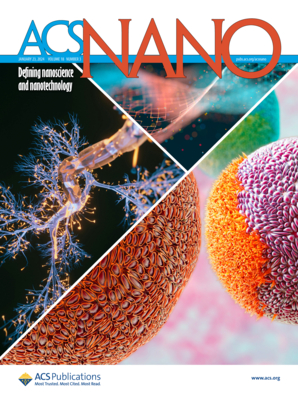Antifungal Performance and Mechanisms of Carbon Quantum Dots in Cellulosic Materials
IF 15.8
1区 材料科学
Q1 CHEMISTRY, MULTIDISCIPLINARY
引用次数: 0
Abstract
Cellulosic materials, which are widely utilized in daily life, are highly susceptible to fungal degradation. However, commercial fungicides are usually toxic, posing severe threats to human health and the environment, highlighting the necessity of developing eco-friendly antifungal agents for cellulosic materials. In this work, we synthesized nitrogen-doped carbon quantum dots (CQDs) via a microwave-assisted method. CQDs with proper structure demonstrated significant antifungal effects against both brown-rot (Postia placenta, Pp) and white-decay fungi (Trametes versicolor, Tv) on various cellulosic materials. The underlying antifungal mechanisms of CQDs on cellulosic materials were further elucidated. We found that positively charged nanosized CQDs primarily adhered to and penetrated into fungal cell membranes. This led to fungal metabolism disorder, a significant reduction in enzymatic activities, and ultimately cell death, as confirmed by transcriptome analysis. Additionally, CQDs generated reactive oxygen species (ROS) under light, causing oxidation and dysfunction of the fungal cell wall. Furthermore, CQDs have the ability to chelate Fe3+, which results in the inhibition of the Fenton reaction and the hindering of the nonenzymatic cellulose degradation. These findings suggest that CQDs inhibit fungal degradation of cellulosic materials through integrated mechanisms, with potential implications for sustainable cellulose applications.

求助全文
约1分钟内获得全文
求助全文
来源期刊

ACS Nano
工程技术-材料科学:综合
CiteScore
26.00
自引率
4.10%
发文量
1627
审稿时长
1.7 months
期刊介绍:
ACS Nano, published monthly, serves as an international forum for comprehensive articles on nanoscience and nanotechnology research at the intersections of chemistry, biology, materials science, physics, and engineering. The journal fosters communication among scientists in these communities, facilitating collaboration, new research opportunities, and advancements through discoveries. ACS Nano covers synthesis, assembly, characterization, theory, and simulation of nanostructures, nanobiotechnology, nanofabrication, methods and tools for nanoscience and nanotechnology, and self- and directed-assembly. Alongside original research articles, it offers thorough reviews, perspectives on cutting-edge research, and discussions envisioning the future of nanoscience and nanotechnology.
 求助内容:
求助内容: 应助结果提醒方式:
应助结果提醒方式:


